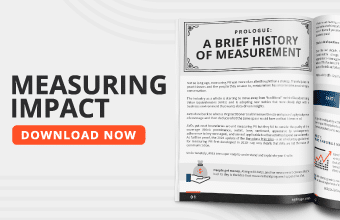The last months of the year are the right moment to set objectives for a new cycle but also to observe what has worked and what could be done better in the year ahead. In order to implement a renewed external communications strategy that considers the needs of the business, we recommend to analyze, measure and understand what works and what doesn’t, observe the competition and identify spaces of opportunity for communication.
Let’s take a closer look at each of the actions mentioned above:
1. Measure what matters: what works (or not) and why?
Number of clicks and ad equivalency are two of the most used metrics in the world of external communication. However, they are not always the most effective way to evaluate your PR efforts. Before choosing the metrics, it is necessary to understand the placement of your company in the market—did it recently arrive to the country? Is it offering something new or unknown to customers? What is your message competing against?
Some examples are: have we reached new media and therefore new audiences? Have we improved our performance Q vs Q? are our messages being prominent in the narrative? Are we being innovative in the way we do our storytelling if we review our efforts over time?
Understanding the context in which the messages are transmitted will make it easier to establish metrics to corroborate the impact achieved. Moreover, these metrics can evolve with time and the company’s objectives.
2. Don’t just get the big picture of your competition, go for the detailed perspective
Observe your competitors with detailed attention, not only in terms of the results they are getting. Recognize as much as you can how they are rolling out their strategy, which messages they are positioning and the channels where they are getting the best results. With this information, you can identify the topics where the competition is a thought leader (and how, through public relations, it is possible to start gaining ground), the subjects where they lack knowledge, and the saturated topics that are not newsworthy anymore for the media and the audience.
In addition, it is a way to identify good practices and to recognize mistakes that have resulted in crises, and that we must avoid.
3. Look for white spaces of opportunity
This action depends on the previous ones, since by understanding the context in which we are positioning the brand’s messages and knowing the competition, it is easier to identify new communication opportunities or point out some strategy that we have missed this year and that can be exploited in 2023.
For example, you may have a spokesperson who is an expert on a new topic that is gaining notoriety in the media and is in line with the brand’s key messages. In this case you can create valuable content about it—beyond mentioning the advantages of one of the brand’s products or services—and manage opportunities where the star spokesperson and the journalists covering the topic can get to know each other.
The lessons learned from implementing these three actions will provide a stable foundation to create a new external communications plan. This doesn’t mean it can’t be adapted as the needs of the company and the media change, but it does offer a safer road to travel.





